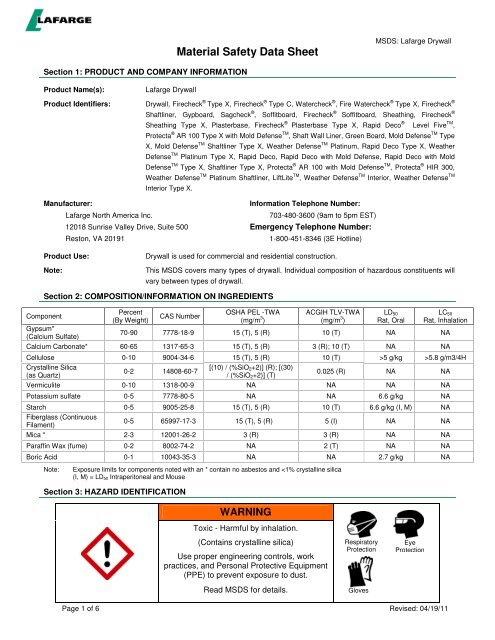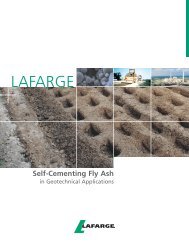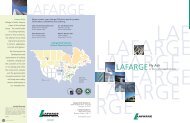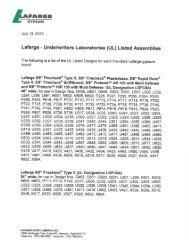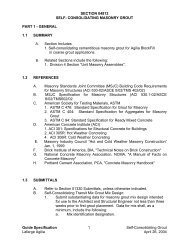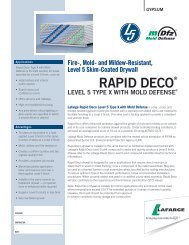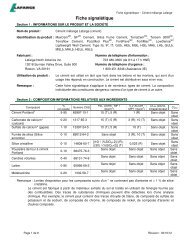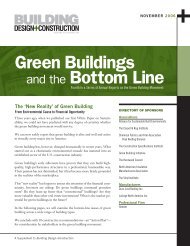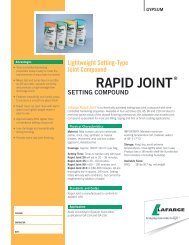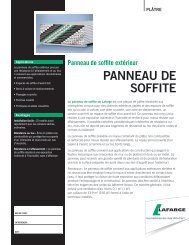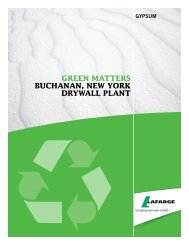Drywall - MSDS English - Lafarge
Drywall - MSDS English - Lafarge
Drywall - MSDS English - Lafarge
- No tags were found...
You also want an ePaper? Increase the reach of your titles
YUMPU automatically turns print PDFs into web optimized ePapers that Google loves.
Material Safety Data Sheet<strong>MSDS</strong>: <strong>Lafarge</strong> <strong>Drywall</strong>Section 1: PRODUCT AND COMPANY INFORMATIONProduct Name(s):<strong>Lafarge</strong> <strong>Drywall</strong>Product Identifiers: <strong>Drywall</strong>, Firecheck ® Type X, Firecheck ® Type C, Watercheck ® , Fire Watercheck ® Type X, Firecheck ®Shaftliner, Gypboard, Sagcheck ® , Soffitboard, Firecheck ® Soffitboard, Sheathing, Firecheck ®Sheathing Type X, Plasterbase, Firecheck ® Plasterbase Type X, Rapid Deco ® Level Five TM ,Protecta ® AR 100 Type X with Mold Defense TM , Shaft Wall Liner, Green Board, Mold Defense TM TypeX, Mold Defense TM Shaftliner Type X, Weather Defense TM Platinum, Rapid Deco Type X, WeatherDefense TM Platinum Type X, Rapid Deco, Rapid Deco with Mold Defense, Rapid Deco with MoldDefense TM Type X, Shaftliner Type X, Protecta ® AR 100 with Mold Defense TM , Protecta ® HIR 300,Weather Defense TM Platinum Shaftliner, LiftLite TM , Weather Defense TM Interior, Weather Defense TMInterior Type X.Manufacturer:Information Telephone Number:<strong>Lafarge</strong> North America Inc.703-480-3600 (9am to 5pm EST)12018 Sunrise Valley Drive, Suite 500 Emergency Telephone Number:Reston, VA 201911-800-451-8346 (3E Hotline)Product Use:Note:<strong>Drywall</strong> is used for commercial and residential construction.This <strong>MSDS</strong> covers many types of drywall. Individual composition of hazardous constituents willvary between types of drywall.Section 2: COMPOSITION/INFORMATION ON INGREDIENTSComponentPercent(By Weight)CAS NumberOSHA PEL -TWA(mg/m 3 )ACGIH TLV-TWA(mg/m 3 )LD 50Rat, OralLC 50Rat, InhalationGypsum*(Calcium Sulfate)70-90 7778-18-9 15 (T), 5 (R) 10 (T) NA NACalcium Carbonate* 60-65 1317-65-3 15 (T), 5 (R) 3 (R); 10 (T) NA NACellulose 0-10 9004-34-6 15 (T), 5 (R) 10 (T) >5 g/kg >5.8 g/m3/4HCrystalline Silica(as Quartz)0-2 14808-60-7[(10) / (%SiO 2+2)] (R); [(30)/ (%SiO 2+2)] (T)0.025 (R) NA NAVermiculite 0-10 1318-00-9 NA NA NA NAPotassium sulfate 0-5 7778-80-5 NA NA 6.6 g/kg NAStarch 0-5 9005-25-8 15 (T), 5 (R) 10 (T) 6.6 g/kg (I, M) NAFiberglass (ContinuousFilament)0-5 65997-17-3 15 (T), 5 (R) 5 (I) NA NAMica * 2-3 12001-26-2 3 (R) 3 (R) NA NAParaffin Wax (fume) 0-2 8002-74-2 NA 2 (T) NA NABoric Acid 0-1 10043-35-3 NA NA 2.7 g/kg NANote:Exposure limits for components noted with an * contain no asbestos and
<strong>MSDS</strong>: <strong>Lafarge</strong> <strong>Drywall</strong>Section 3: HAZARD IDENTIFICATION (continued)Emergency Overview:<strong>Drywall</strong> is a sold material that is composed of paper covered gypsum board. Thepaper covering can be gray, green, brown, blue, or white while the internal gypsumboard is an off-white color. <strong>Drywall</strong> is odorless. <strong>Drywall</strong> is not combustible orexplosive. A single, short-term exposure to drywall dust presents little or no hazard.Potential Health Effects:Eye Contact:Skin Contact:Inhalation (acute):Inhalation (chronic):Silicosis:Eye contact to airborne dust may cause immediate or delayed irritation orinflammation. Eye exposures require immediate first aid and medical attention toprevent significant damage to the eye.<strong>Drywall</strong> dust may cause dry skin, discomfort, and irritation.Breathing dust may cause nose, throat or lung irritation, including choking, dependingon the degree of exposure.Risk of injury depends on duration and level of exposure.This product contains crystalline silica. Prolonged or repeated inhalation of respirablecrystalline silica from this product can cause silicosis, a seriously disabling and fatallung disease. See Note to Physicians in Section 4 for further information.This product contains mica. Prolonged and repeated inhalation of respirable micadust may cause lung disease (pneumoconiosis). The extent and severity of lunginjury depends on duration and level of exposure.Carcinogenicity:AutoimmuneDisease:Tuberculosis:Renal Disease:Ingestion:Crystalline silica is classified by IARC and NTP as a known human carcinogen.Some studies show that exposure to respirable crystalline silica (without silicosis) orthat the disease silicosis may be associated with the increased incidence of severalautoimmune disorders such as scleroderma (thickening of the skin), systemic lupuserythematosus, rheumatoid arthritis and diseases affecting the kidneys.Silicosis increases the risk of tuberculosis.Some studies show an increased incidence of chronic kidney disease and end-stagerenal disease in workers exposed to respirable crystalline silica.Do not ingest drywall. Ingestion of small quantities of drywall is not known to beharmful; ingesting large quantities can cause intestinal distress.Medical Conditions Individuals with lung disease (e.g. bronchitis, emphysema, COPD, pulmonaryAggravated by Exposure: disease) can be aggravated by exposure.Section 4: FIRST AID MEASURESEye Contact:Skin Contact:Inhalation:Ingestion:Rinse eyes thoroughly with water for at least 15 minutes, including under lids, toremove all particles. Seek medical attention for abrasions.Wash with cool water and a pH neutral soap or a mild skin detergent. Seek medicalattention for rash or irritation.Move person to fresh air. Seek medical attention for discomfort or if coughing orother symptoms do not subside.Do not induce vomiting. If conscious, have person drink plenty of water. Seekmedical attention or contact poison control center immediately.Page 2 of 6 Revised: 04/19/11
<strong>MSDS</strong>: <strong>Lafarge</strong> <strong>Drywall</strong>Section 4: FIRST AID MEASURES (continued)Note to Physician:The three types of silicosis include:Section 5: FIREFIGHTING MEASURES• Simple chronic silicosis – which results from long-term exposure (more than20 years) to low amounts of respirable crystalline silica. Nodules of chronicinflammation and scarring provoked by the respirable crystalline silica form inthe lungs and chest lymph nodes. This disease may feature breathlessnessand may resemble chronic obstructive pulmonary disease (COPD).• Accelerated silicosis – occurs after exposure to larger amounts of respirablecrystalline silica over a shorter period of time (5-15 years). Inflammation,scarring, and symptoms progress faster in accelerated silicosis than insimple silicosis.• Acute silicosis – results from short-term exposure to very large amounts ofrespirable crystalline silica. The lungs become very inflamed and may fill withfluid, causing severe shortness of breath and low blood oxygen levels.Progressive massive fibrosis may occur in simple or accelerated silicosis, but is morecommon in the accelerated form. Progressive massive fibrosis results from severescarring and leads to the destruction of normal lung structures.Flashpoint & Method: Non-combustible Combustion Products: None.General Hazard:Extinguishing Media:Flammability(UL classification):Avoid breathing dust.Use extinguishing mediaappropriate for surroundingfire.Section 6: ACCIDENTAL RELEASE MEASURESFirefighting Equipment:<strong>Drywall</strong> poses no firerelatedhazard. A SCBA isrecommended to limitexposures to combustionproducts when fighting anyfire.Flame spread: 10 or 15 Smoke development: 0 Non-combustible coreGeneral:Place broken material and drywall dust into a container. Avoid actions that causedust to become airborne. Avoid inhalation of dust. Wear appropriate protectiveequipment as described in Section 8.Waste Disposal Method: Dispose of drywall according to Federal, State, Provincial and Local regulations.Section 7: HANDLING AND STORAGEGeneral:Minimize dust generation and accumulation. Use good safety and industrial hygienepractices.Follow traditional building practices; such as management of water away form theinterior of the structure to avoid the growth of mold, mildew and fungus. Remove anybuilding products suspected of being exposed to sustained moisture and consideredconducive to mold growth from the jobsite.When moving board with a forklift or similar equipment, it is essential that theequipment be rated capable of handling the loads. The forks should always be longenough to extend completely through the width of the load. Fork spacing betweensupports should be one half the length of the panels or base being handled so that amaximum of 4 feet extends beyond the supports on either end.Page 3 of 6 Revised: 04/19/11
Section 7: HANDLING AND STORAGE (continued)<strong>MSDS</strong>: <strong>Lafarge</strong> <strong>Drywall</strong><strong>Drywall</strong> is heavy and poses risks such as sprains and strains to the back, arms,shoulders and legs during lifting and mixing. Handle with care and use appropriatecontrol measures.Usage:Housekeeping:Storage:Cutting, crushing or sanding drywall or other crystalline silica-bearing materials willrelease respirable crystalline silica. Use all appropriate measures of dust control orsuppression, and Personal Protective Equipment (PPE) described in Section 8below.Avoid actions that cause dust to become airborne during clean-up such as drysweeping or using compressed air. Use HEPA vacuum or thoroughly wet with waterto clean-up dust. Use PPE described in Section 8 below.Store in a cool, dry, ventilated area away from sources of heat, moisture andincompatibilities, as described in Section 10. Protect product from physical damage.Protect from weather and prevent exposure to sustained moisture.Gypsum Association literature recommends storing board flat to avoid damagingedges, warping the board and the potential safety hazards of the board falling over.However, in other situations, storing the board flat may cause a tripping hazard orexceed floor limit loads. If stacking board vertically, leave at least 4 inches from thewall to decrease the risk of falling board and no more than 6 inches to avoid toomuch lateral weight against the wall.Storage Temperature:Storage Pressure:Clothing:<strong>Drywall</strong> should not be used where temperatures exceed 125º F for extended periodsor in areas of extreme humidity.Unlimited.Remove and launder clothing that is dusty before it is reused.Section 8: EXPOSURE CONTROLS AND PERSONAL PROTECTIONEngineering Controls:Use local exhaust or general dilution ventilation or other suppression methods tomaintain dust levels below exposure limits.Personal Protective Equipment (PPE):RespiratoryProtection:Eye Protection:Skin Protection:Under ordinary conditions no respiratory protection is required. Wear a NIOSHapproved respirator that is properly fitted and is in good condition when exposed todust above exposure limits.Wear ANSI approved glasses or safety goggles when handling drywall to preventdust coming in contact with eyes. Wearing contact lenses when using drywall, underdusty conditions, is not recommended.Wear gloves when handling drywall. Remove clothing and protective equipment thatbecomes dusty and launder before reusing.Section 9: PHYSICAL AND CHEMICAL PROPERTIESPhysical State: Solid Evaporation Rate: NA.Appearance: Variety of paper colors, with white core pH (in water): NeutralOdor: None. Boiling Point: NAVapor Pressure: NA. Freezing Point: None, solid.Vapor Density: NA. Viscosity: None, solid.Specific Gravity: 1.1 to 4.0 lbs/ft 2 Solubility in Water: < 0.2% @ 20º CPage 4 of 6 Revised: 04/19/11
<strong>MSDS</strong>: <strong>Lafarge</strong> <strong>Drywall</strong>Section 10: STABILITY AND REACTIVITYStability:Incompatibility:Stable. Avoid contact with incompatible materials.The components of drywall are incompatible with strong oxidizers, strong acids,diazomethane, ammonium salts, aluminum, and fluorine.Hazardous Polymerization:None.Hazardous Decomposition: Thermal decomposition may yield sulfur oxides, and calcium oxide fumes (above825ºC).Section 11 and 12: TOXICOLOGICAL AND ECOLOGICAL INFORMATIONFor questions regarding toxicological and ecological information refer to contact information in Section 1.Section 13: DISPOSAL CONSIDERATIONSDispose of waste and containers in compliance with applicable Federal, State, Provincial and Local regulations.Section 14: TRANSPORT INFORMATIONThis product is not classified as a Hazardous Material under U.S. DOT or Canadian TDG regulations.Section 15: REGULATORY INFORMATIONOSHA/MSHA HazardCommunication:CERCLA/SUPERFUND:EPCRASARA Title III:EPRCASARA Section 313:RCRA:TSCA:CaliforniaProposition 65:WHMIS/DSL:This product is considered by OSHA/MSHA to be a hazardous chemical and shouldbe included in the employer's hazard communication program.This product is not listed as a CERCLA hazardous substance.This product has been reviewed according to the EPA Hazard Categoriespromulgated under Sections 311 and 312 of the Superfund Amendment andReauthorization Act of 1986 and is considered a hazardous chemical and a delayedhealth hazard.This product contains none of the substances subject to the reporting requirements ofSection 313 of Title III of the Superfund Amendments and Reauthorization Act of1986 and 40 CFR Part 372.If discarded in its purchased form, this product would not be a hazardous wasteeither by listing or characteristic. However, under RCRA, it is the responsibility of theproduct user to determine at the time of disposal, whether a material containing theproduct or derived from the product should be classified as a hazardous waste.Crystalline silica is exempt from reporting under the inventory update rule.Crystalline silica (airborne particulates of respirable size) is known by the State ofCalifornia to cause cancer.Products containing crystalline silica and calcium carbonate are classified as D2Aand are subject to WHMIS requirements.Page 5 of 6 Revised: 04/19/11
<strong>MSDS</strong>: <strong>Lafarge</strong> <strong>Drywall</strong>Section 16: OTHER INFORMATIONAbbreviations:> Greater than NA Not ApplicableACGIHAmerican Conference of GovernmentalIndustrial HygienistsNFPA National Fire Protection AssociationCAS No Chemical Abstract Service number NIOSHNational Institute for Occupational Safetyand HealthComprehensive EnvironmentalNTP National Toxicology ProgramCERCLA Response, Compensation and LiabilityOccupational Safety and HealthOSHAActAdministrationCFR Code for Federal Regulations PEL Permissible Exposure LimitCL Ceiling Limit pH Negative log of hydrogen ionDOT U.S. Department of Transportation PPE Personal Protective EquipmentEST Eastern Standard Time R Respirable ParticulateHEPA High-Efficiency Particulate Air RCRA Resource Conservation and Recovery ActHMISHazardous Materials IdentificationSuperfund Amendments andSARASystemReauthorization ActIARCInternational Agency for Research on T Total ParticulateCancer TDG Transportation of Dangerous GoodsLC 50 Lethal Concentration TLV Threshold Limit ValueLD 50 Lethal Dose TWA Time Weighted Average (8 hour)mg/m 3 Milligrams per cubic meterWorkplace Hazardous MaterialsWHMISMSHA Mine Safety and Health AdministrationInformation SystemThis <strong>MSDS</strong> (Section 1) was revised on April 19, 2011.An electronic version of this <strong>MSDS</strong> is available at: www.lafarge-na.com under the Sustainability section.<strong>Lafarge</strong> North America Inc. (LNA) believes the information contained herein is accurate; however, LNA makes noguarantees with respect to such accuracy and assumes no liability in connection with the use of the informationcontained herein which is not intended to be and should not be construed as legal advice or as insuringcompliance with any federal, state or local laws or regulations. Any party using this product should review all suchlaws, rules, or regulations prior to use, including but not limited to US and Canada Federal, Provincial and Stateregulations.NO WARRANTY IS MADE, EXPRESS OR IMPLIED, OF MERCHANTABILITY, FITNESS FOR A PARTICULARPURPOSE, OR OTHERWISE.Page 6 of 6 Revised: 04/19/11


